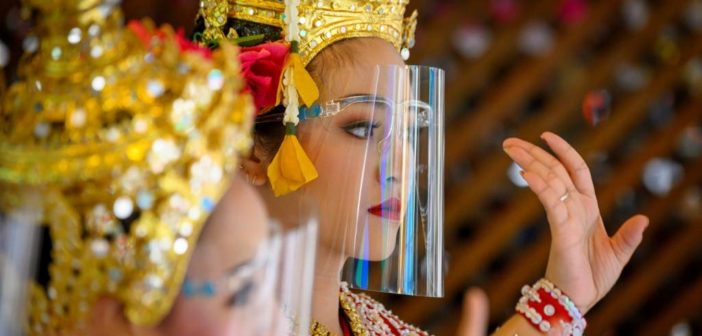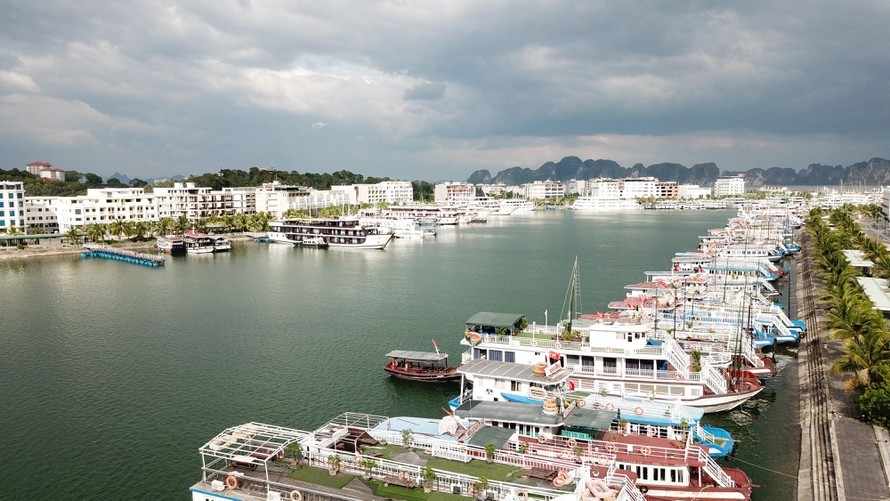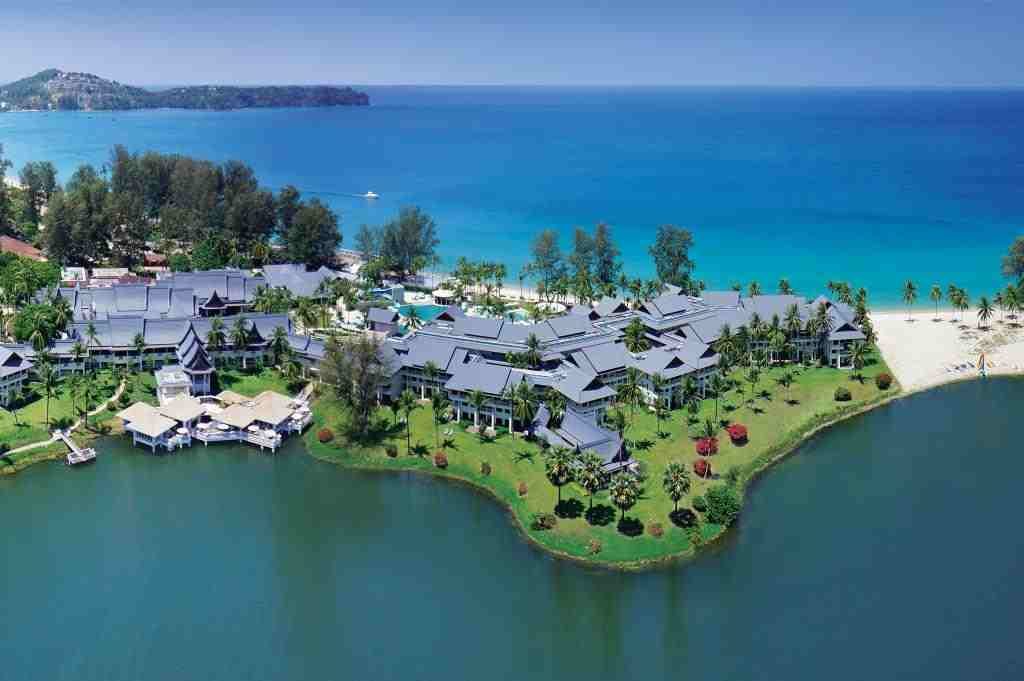Nội dung
How to Bring Southeast Asia Tourism out of the Spiral of the COVID-19 Pandemic? ASEAN countries have implemented many solutions to revive the tourism industry, which is almost in a state of “freezing” and has suffered heavy losses due to the COVID-19 pandemic.
Phuket International Airport staff hold a sign with the words ”sandbox” to lead the first group of guests to the island. (Source: Bangkok Post)
The first 300 international tourists arrived on the Thai island of Phuket on July 1 as the country struggled to restore the tourism industry devastated by the COVID-19 epidemic.
The “Phuket Sandbox,” a pilot program open to fully vaccinated and certified COVID-19-free foreign visitors, makes Phuket the first destination in the Southeast Asian country to welcome visitors. back schedule.
Flights from Israel, the United Arab Emirates (UAE), Qatar, Singapore… landed on this famous resort island in the Andaman Sea on July 1 with hopes of revitalizing the capital economy. rely on Thailand’s “smokeless industry”. This is the first step in efforts to realize the goal of opening tourist attractions to foreign tourists who have been vaccinated by early October.
Not only Thailand, other countries in Southeast Asia have also implemented many solutions to revive the tourism industry, which is almost in a state of “freezing” and has suffered heavy losses due to the COVID-19 pandemic.
Thailand lost about 50 billion USD in tourism revenue last year, when the number of international visitors decreased by 83% compared to 2019. This is a significant loss considering the contribution of the Thai tourism industry to the Gross Domestic Product. Domestic product (GDP) in 2019 accounted for 18%, of which 12% came from international tourists.
Last year, the number of international tourists to Cambodia decreased by 80.2% compared to 2019, causing international tourism revenue to also decrease by 79.2%. This decline resulted in the tourism industry’s contribution to GDP being only 3% in 2020, from 12.1% the previous year. New outbreaks this year have made the situation even more difficult. In the first quarter of this year, the number of international tourists to Cambodia decreased by 93.9% compared to the same period in 2020.
Southeast Asia Tourim: Vietnam Faces to The Pandemic of Covid-19
Vietnam’s tourism is not immune to the general decline trend. According to the General Statistics Office, last year, the number of international visitors to Vietnam decreased by 79.5% compared to 2019, domestic visitors decreased by 34.1%; total tourism revenue decreased by 58.7% (equivalent to 19 billion USD). About 40-60% of workers lost their jobs or cut their working days. About 95% of international tour operators have stopped operating.
It can be said that COVID-19 is really a big shock to the tourism industry of the Association of Southeast Asian Nations (ASEAN), where before the pandemic welcomed about 143.59 million international visitors in 2019, accounting for nearly 143 million international visitors. 9.6% of total international tourist arrivals worldwide; growth rate reached 6.1%, higher than the global growth rate of 4%, with revenue of $380 billion and creation of 42.3 million jobs. For many countries, tourism is a key economic sector contributing significantly to GDP.
In such a difficult context, since last year, Southeast Asian countries have found many different ways to maintain the operation of the tourism industry. As most countries had to close their borders to prevent the spread of the virus, most ASEAN countries identified the domestic market as the “fulcrum.”
“Phuket Sandbox”: Thailand welcomes its first international visitors
Thailand’s “We Travel Together” program worth 22.4 billion baht (about 720 million USD), applied until the end of August 2021, provides 5 million nights of accommodation at hotels and resorts in the country. and 2 million air tickets, with the price only 40% of the normal rate.
In Indonesia, a stimulus package worth 25 trillion rupiah ($1.7 billion) is implemented in the form of direct discounts on airfares and hotel rooms as well as offering discount tour vouchers on online applications. line within the framework of the national economic recovery program with a total value of nearly 320,000 billion Rupiah.
Singapore launched a domestic tourism stimulus package worth 450 million SGD, while Malaysia in June 2020 announced a tax incentive measure for tourism services valid for one year and reduced personal income tax up to 1,000. RM for domestic travel expenses until 31 Dec 2021.
In Vietnam, in addition to a series of policies and solutions to remove difficulties and support tourism businesses implemented by the government, the program “Vietnamese people travel to Vietnam” was launched from the beginning of May 2020. Along with the message “Safe and attractive tourism in Vietnam” has helped the tourism market to be vibrant again, the frequency of domestic flights has gradually recovered, even increased, the capacity of rooms has increased sharply again. , some places reach 80-90% on weekends.
Earlier this year, the fact that many countries around the world began to deploy vaccination, gradually opening their borders, brought hope to the ASEAN region. Indonesia is applying a safe tourism campaign called “Indonesia care”.nesia care”, and is promoting the implementation of a “tourist bubble” program with many countries including the United Arab Emirates. (UAE), Qatar, China, Singapore and the Netherlands.
The Indonesian government aims to attract 7 million foreign visitors this year, while the Indonesian Hotel and Restaurant Association (PHRI) target is 13-14 million with a forecast that visitors will start returned to the country three months after the nationwide vaccination program against COVID-19 was launched on January 13.
Thailand’s tourism incentive program has been launched in Phuket island, which is expected to expand to other tourist destinations such as Koh Samui, Koh Tao and Koh Phangan, which the Tourism Authority of Thailand (TAT) hopes will There are 100,000 foreign visitors to Phuket in the third quarter of this year and will generate revenue of about 8.9 billion baht (about 277 million USD).
The Cambodian government has also developed a draft plan to recover the tourism industry during and after the COVID-19 pandemic, including three phases. The current phase focuses on crisis management in a flexible, new normal, and a relaunch of the service industry. The period 2022-2023 is to recover tourism from the COVID-19 crisis and prepare for the resurgence of this service industry in the period 2024-2025.
Most countries promote vaccination programs to facilitate the opening of tourism. In Thailand, as of June 27, 63% of people in Phuket province received a second dose of COVID-19 vaccine. …
Indonesia is also implementing the establishment of “green zones” or “no COVID-19 corridors” at tourist destinations such as Bintan island, Batam in the province of Riau Islands, and Bali island with priority given to the supply of vaccines for at least 70 % of local residents in July.
However, new waves of infection after the appearance of a new variant of COVID-19 caused many regional countries to struggle against the epidemic. This is creating many challenges for the efforts of ASEAN countries.
Even Indonesia on July 1 decided to suspend tourism recovery programs such as reopening Bali to foreign tourists, a vaccine-based tourism program and a travel corridor agreement (TCA). program “Work from Bali” due to the imposition of emergency restrictions on community activities here. The country is witnessing a sudden increase in the number of COVID-19 cases with nearly 24,900 cases on July 1.
The number of new cases per day is still up to about 7,000 cases, also forcing the Philippines, the second largest epidemic area in Southeast Asia after Indonesia, to continue to close its doors to international tourists. The Philippines is looking to boost domestic tourism, setting up a “tourist bubble” among several provinces.
However, the fact that the capital Manila and a number of areas were put under blockade to prevent the new variant caused many tourists to cancel their travel plans. Cambodia, Malaysia… also face similar difficulties when COVID-19 is not under control.
Southeast Asia Travel Restrictions: Vaccine Passport Must Be Required
The latest report of the United Nations World Tourism Organization (UNWTO) predicts that the global smokeless industry will not be able to fully recover until 2023.
The report states that vaccination against COVID-19 and certification of COVID-19 are key factors in helping to restore the tourism industry, however, in the context of the world’s COVID-19 vaccination rate is still not uniform. Evenly, many countries have vaccination rates up to 60%, but in many countries the rate is less than 1%, tourism recovery continues to be a difficult problem.
In particular, when new variants of the SARS-CoV-2 virus are constantly appearing, posing the risk of a new epidemic wave at any time, experts say that any plan to restore tourism will need to ensure the safety factor with careful steps. In other words, the tourism industry can only recover sustainably when safe destinations are built.
According to experts, in order to bring ASEAN’s tourism industry out of the “spiral” of COVID-19, regional countries need to strengthen cooperation not only bilaterally but also multilaterally to be well prepared for the pandemic. resume tourism activities within the bloc as well as outside the bloc.
As early as April 2020, a special ASEAN Tourism Ministers Meeting on COVID-19 was held to discuss a coordinated action plan to protect tourism businesses and workers in the tourism industry from overcoming the crisis caused by the COVID-19 pandemic.
At the 37th ASEAN Summit on November 12, 2020, under the chairmanship of Vietnam in the role of ASEAN Chair, the leaders adopted the Joint Statement on ASEAN Digital Tourism. This is an initiative proposed by Vietnam with the goal of developing sustainable and comprehensive Southeast Asia tourism after the crisis of the COVID-19 pandemic.





